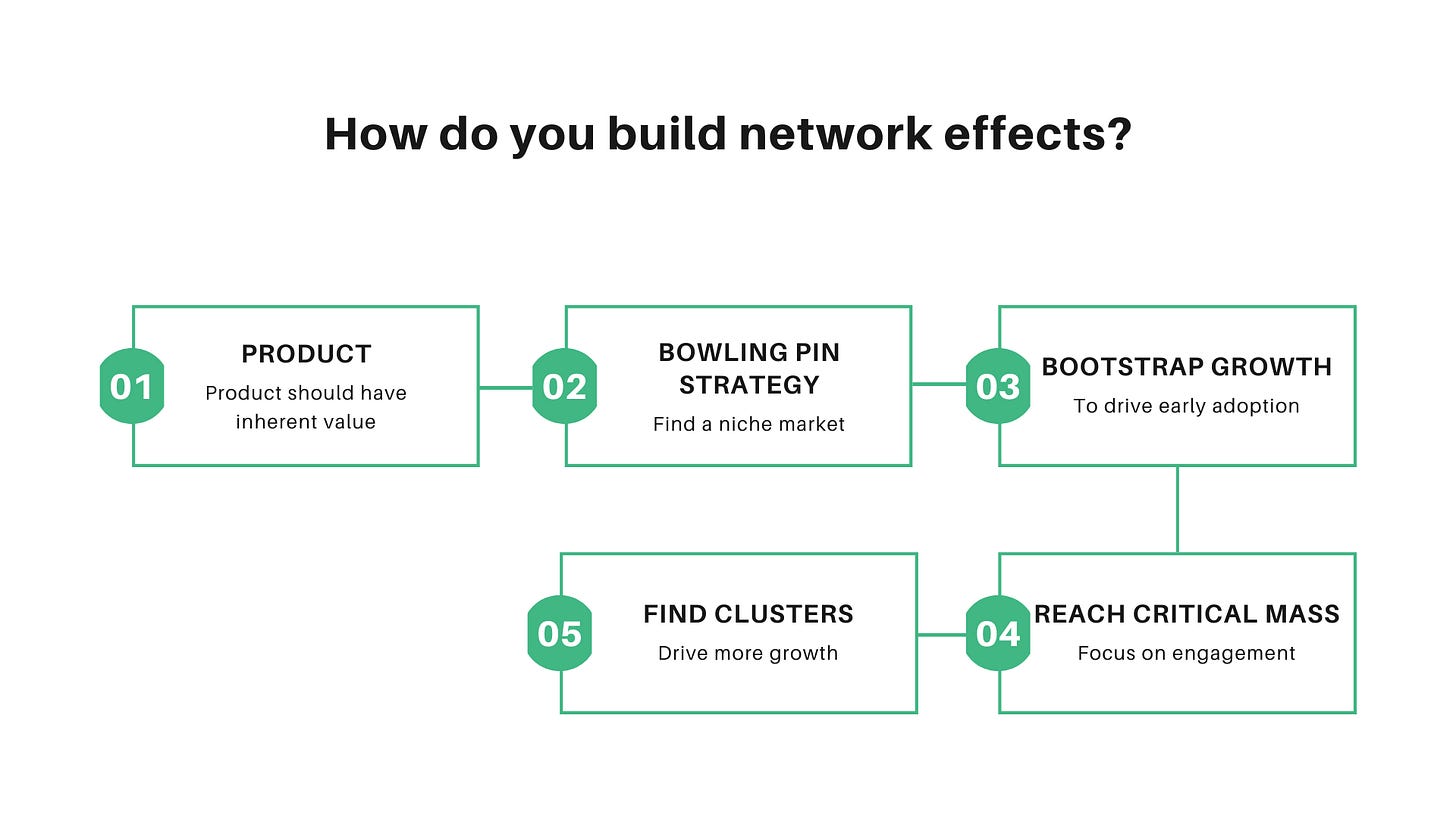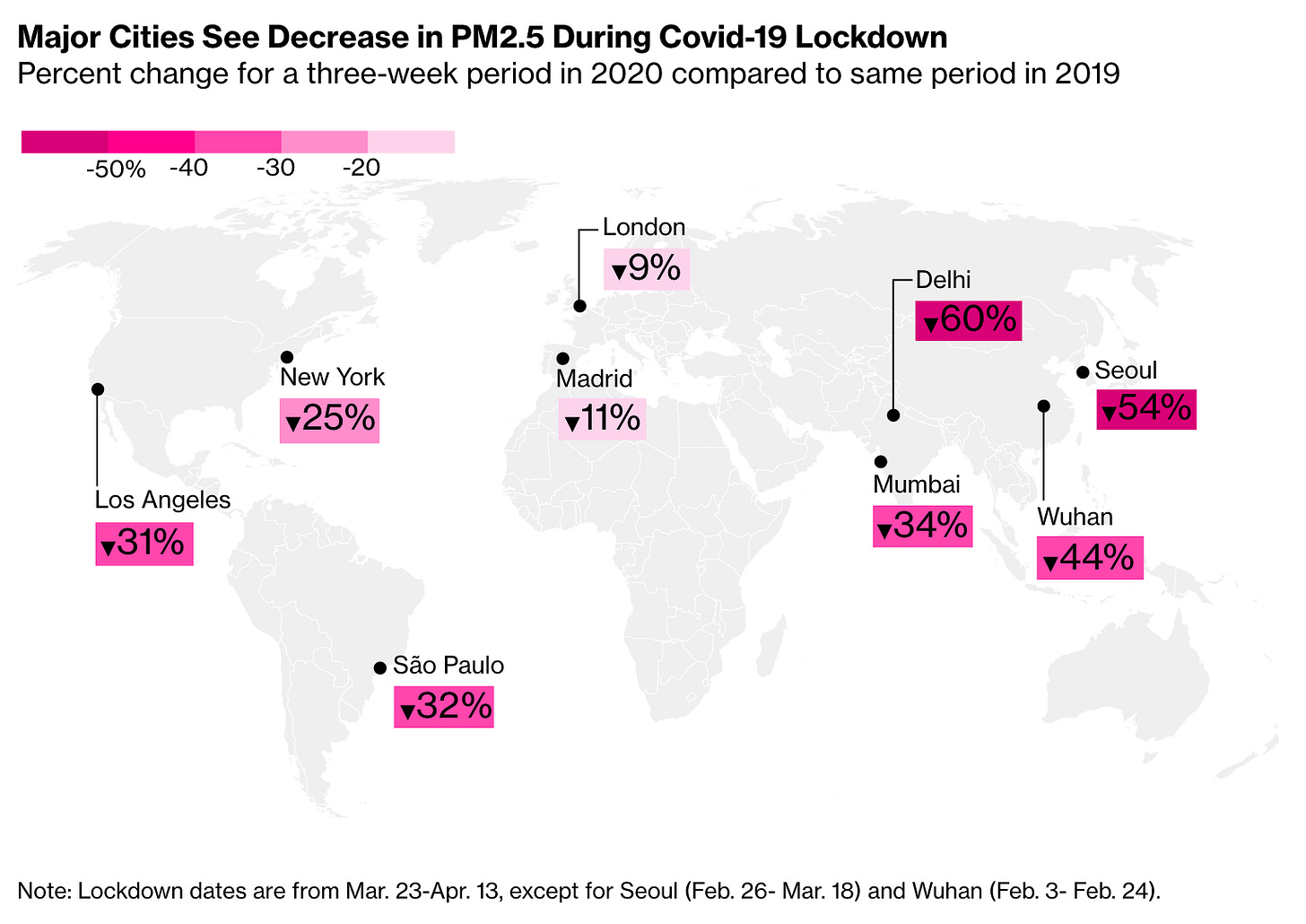Newsletter #20: network effects 2
12 minutes reading time. Thoughts on startups, growth, and technology 🚀
Hey there,
Last week, I dived into the topic of network effects and provided a few examples of companies exhibiting such dynamics.
Since the concept is tricky and hard to describe, I find the following quote by Bill Gurley as helpful in understanding network effects:
“Can the marketplace provide a better experience to customer “n+1000” than it did to customer “n” directly as a function of adding 1000 more participants to the market? You can pose this question to either side of the network – demand or supply. If you have something like this in place it is magic, as you will get stronger over time not weaker.”
Once you understand the benefits, naturally the next question is how do you build and maintain such a competitive advantage for your business?
Before we dive into strategies for triggering network effects, I would like to clarify that everything starts with your product. Your number one priority must be aways to build a product that provides inherent value. As Peter Thiel argues:
“Network effects can be powerful, but you’ll never reap them unless your product is valuable to its very first users when the network is necessarily small….Paradoxically, then, network effects businesses must start with especially small markets. Facebook started with just Harvard students–Mark Zuckerberg’s first product was designed to get all his classmates signed up, not to attract all people of Earth. This is why successful network businesses rarely get started by MBA-types: the initial markets are so small that they often don’t even appear to be business opportunities at all.”
Let's follow Peter Thiel's chain of thoughts here, thus, describe what history has proved to trigger network effects.
Find a niche market - Focus on a small market until you dominate it and then gradually move to other niche markets (think Facebook going first after Harvard, then to other universities, and eventually to other segments and even countries before building global presence).
a16z refers to this as a Bowling pin strategy:

Bootstrap growth to drive early adoption - Once you identify the small markets you want to go after, the next step is to bootstrap growth. That strategy is well described in one of my previous posts on “do things that do not scale”. A few notable examples here are:
Facebook - accessed the entire Harvard directory early on to provide immediate utility for early adoption.
Reddit - created several accounts on their own and started submitting interesting content to make the site feel alive for new users.
Such activities are definitely laborious at first, but necessary as they help founders to drive adoption when the product is still not good enough.
In Paul Graham's words:
“The need to do something unscalably laborious to get started is so nearly universal that it might be a good idea to stop thinking of startup ideas as scalars. Instead, we should try thinking of them as pairs of what you're going to build, plus the unscalable thing(s) you're going to do initially to get the company going.”
3. Critical mass - Next your objective becomes attracting a critical mass of users, and when speaking of critical mass I would like to use the words of Peter Bevelin to showcase what is meant here:
“At a certain scale, a system reaches a critical mass or a limit where the behavior of the system may change dramatically. It may work better, worse, cease to work or change properties. Small interactions over time slowly accumulate into a critical state — where the degree of instability increases. A small event may then trigger a dramatic change like an earthquake. A small change may have no effect on a system until a critical threshold is reached. For example, a drug may be ineffective up until a certain threshold and then become effective, or it may become more and more effective, but then become harmful...”
As mentioned in the previous post, Facebook identified that connecting a new user to 10 friends within 14 days of sign up was critical to improving retention. As a result, they used email contact imports, suggested friends-features, and embedded widgets to drive engagement.
Another example is Tilt, in their early days, the founders noticed that campaigns were 75% more likely to tilt if at least 3 friends are tagged.

Identifying the critical mass threshold for your business is important as it gives you guidance on what metrics you need to focus on in order to accelerate growth and engagement. Typically, reaching critical mass goes hand in hand with rolling out new features that drive engagement e.g. Facebook kept on introducing new features such as the like button, news feed, chat, etc.
Assuming a company does all that a) Kickstarts a "Bowling pin" strategy to focus on a niche segment, b) Bootstraps growth to drive early adoption, c) Sets goals to help attract "critical mass" quickly, the next step would be to identify and target clusters of relevant users.
4. Clusters of relevant users - For example, WhatsApp was one of the first apps that actually took advantage of people's phonebook contacts to drive growth. Once Apple allowed third-party apps to have access to all those contacts, WhatsApp realized that they are sitting on a lot of clusters of niche segments and systematically targeted them to drive growth.

Having said that, there is no guarantee that things will work out and you will be able to trigger a network effect. Especially if your business is a marketplace as you will always face the chicken vs egg dilemma aka how do you get sufficient supply and demand to have a well-balanced business. In fact, most marketplaces would always find one of the sides (supply vs demand) to be more challenging than the other. Consequentially the most important question here is:
“What's the initial growth lever or tactic to help us get to scale?”
Resources worth checking out:
🎥 What Are Network Effects? (Whiteboard Breakdown) | James Currier / Jan 2020 - In this NFX whiteboarding session, James Currier (Managing Partner at NFX / nfx.com) breaks down what all Founders need to know about network effects, why network effects are the fastest way to build an iconic company and the difference between network effects and growth.
🎥 The Success Equation: Untangling Skill and Luck | Michael Mauboussin | July 2014 - What role, exactly, do skill and luck play in our successes and failures? Some games, like roulette and the lottery, are pure luck. Others, like chess, exist at the other end of the spectrum, relying almost wholly on players' skill. In his provocative book, Michael Mauboussin untangles the intricate strands of skill and luck, defines them, and provides useful frameworks for analyzing their relative contributions. He offers concrete suggestions for how to put these insights to work to your advantage in business and other dimensions of life.
📝 16 Ways to Measure Network Effects | Li Jin and D'Arcy Coolican | Dec 2018 - Every single network effect business is different depending on the particular product, audience, and environment, so there’s no-one-size-fits-all list of measures. In general, however, for two-sided marketplaces matching supply and demand, pay special attention to the marketplace and unit economics sections; for social networks (including workplace ones), what matters most is engagement and activity. In the end, though, it all comes down to the very definition of network effects: whether your product becomes more valuable as more people use it.
A quote worth remembering:
💬 The scientist, astronomer, and author, Carl Sagan, on the magic of books:
"What an astonishing thing a book is. It's a flat object made from a tree with flexible parts on which are imprinted lots of funny dark squiggles. But one glance at it and you're inside the mind of another person, maybe somebody dead for thousands of years. Across the millennia, an author is speaking clearly and silently inside your head, directly to you. Writing is perhaps the greatest of human inventions, binding together people who never knew each other, citizens of distant epochs. Books break the shackles of time. A book is a proof that humans are capable of working magic."
A book recommendation:
📖 An Astronaut's Guide to Life on Earth by Chris Hadfield - Following the historic launch of SpaceX's first crewed mission I would like to recommend my favorite book on the topic of space exploration.
“Depending on your outlook on things, this book will either make you feel like you have lived a vastly underwhelming and underachieving sort of life, full of these lost opportunities, these missed chances... or it will make you feel infinitely inspired, like you can live more and do more just be more in general, and it will serve as fuel to your rocket, to use a hackneyed analogy.”
Positive news worth sharing:

With lockdowns in place, businesses closed and transport at a standstill, air quality has been soaring. Delhi, the 5th most polluted city in the world, has seen a 60% decline in airborne pollutants.
It doesn’t solve the long term problem of toxic air. But it does show how city life could improve if environmental concerns were addressed more urgently.
Check out the source here.
Onward and upward 🚀


